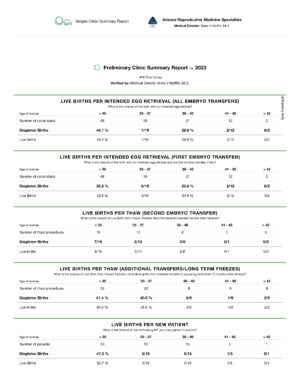Fertility Success Rates
IVF success
For over 25 years our primary mission has been to provide the highest possible success in an extremely sensitive, personal and cost effective manner.
When it comes to success rates, we feel it is our responsibility to provide you honest, accurate and meaningful information so that you can make an informed decision on how to proceed on your journey to have a baby. The challenge is that every person has a unique set of characteristics that make comparisons difficult.
The secret to making an informed decision is to make sure you are comparing yourself to people with similar characteristics.
SART success rates
Society for Assisted Reproductive Technology (SART) statistics do not take into account patient characteristics that have proven to be very important such as egg quality and quantity. We extensively evaluate our patients for egg quality and quantity. Without taking into account this information, no comparison of clinics is possible or valid. Come see us. We provide you with honest and accurate prediction of your chances of IVF success.
SART releases national and clinic-specific IVF cycle data two years after submission. The charts below displays our preliminary 2023 IVF cycle outcomes from SART.
click to expand SART summary report

CDC success rates
Fertility clinics based in the United States report cycles started with the use of assisted reproductive technology to the the Center for Disease Control and Prevention (CDC) annually. Since fertility naturally declines with age, success rates are broke out by a woman’s age. Viewing a clinic’s success rate is one measurement to consider when evaluating them as a whole.
ARMS 2023 success rates
In 2023, our live birth rate per new patient (with no prior ART cycles), after their first retrieval, for patients <35 was 58.7%! Live births after first intended retrieval for new ARMS patients with no prior ART cycles equals the chances of getting pregnant on the first try!
ARMS 2023 CDC success rates

click to expand CDC success rate table
2020 CDC Success Rates
2021 CDC Success Rates
2022 CDC Success Rates
Ongoing pregnancy rates (2024-2025)
Ongoing pregnancy rates give the most current information about what has been happening for the last 9 available reporting months.

Our clinical pregnancy rate for cases with PGT-A (Preimplantation Genetic Testing for chromosomal abnormalities) for all ages is 59.1% (55/93).
Ongoing pregnancy rates are pregnancies that have been documented by a pregnancy in the uterus with a heartbeat confirmed on ultrasound. We present our ongoing pregnancy rates as the most recent nine months because this is the most current data we can provide and because this is the time period that cannot be presented with anything other than ongoing pregnancy rates. The difference between live birth rates and ongoing pregnancy rates is the pregnancy loss rate.
Cumulative pregnancy rates
In many IVF cycles more embryos are created than should be implanted in the mother. Responsible clinics will transfer only one or two embryos and then freeze the rest. The greatest expense in the IVF process is getting the eggs and creating the embryos. What most patients want to know is, “If I do this, what’s my chance of having a baby.” The only way to accurately represent this is to account for all live births that occur from either the transfer of embryos in the cycle in which they were obtained (FRESH) or from the transfer of embryos from the same egg retrieval that were frozen and transferred later (FROZEN). At ARMS we mostly transfer frozen embryos.
Cumulative live birth rates

Cumulative live birth rate is the most meaningful way to present IVF outcomes. Live birth rates are babies actually born alive to our patients. The only problem with presenting data this way is you have to wait for the babies to be born and you have to rely on the patients to provide that outcome data. The process of waiting for the babies to be born and the obtaining, validating and organizing the data usually means that the live birth data is delayed by one year. In order to present the cumulative live birth rate, you must account for the babies born from not only the fresh cycle, but the frozen cycles too. This means that this data is always going to be delayed by two years.
Fertility Treatment Success
Some clinics encourage a comparison of pregnancy rates between clinics based on statistics available through government agencies or professional organizations. Such comparisons are not valid due to the fact that the information provided by these companies does not control for even the most critical variables such as egg quality or sperm quality. These agencies specifically state, “A comparison of clinic success rates may not be meaningful because patient medical characteristics, treatment approaches, and entry criteria for ART may vary from clinic to clinic.”
The only possible comparison between clinics that can be made is between donor egg programs, since this controls for egg quality. Even this does not control for sperm quality or other critical factors. Our Donor Egg Program has consistently had between a 50 and 85 percent live birth rate.
